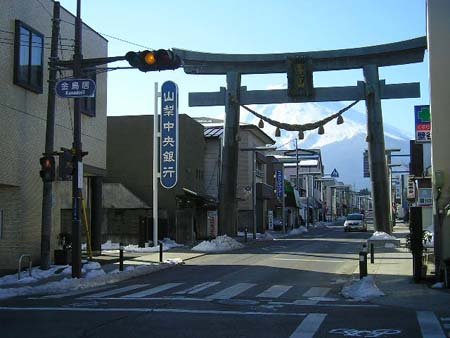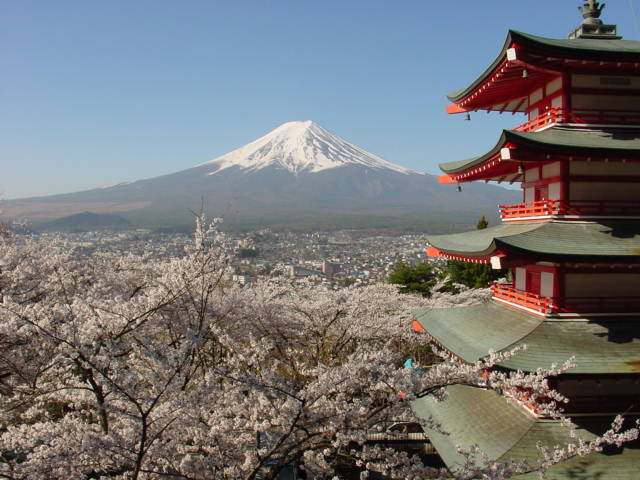
During my quick stay in my hometown this time, I had a chance to visit Fujiyoshida City for some personal business with my family. We could stay there only for a half day, but I was surprised to feel "the scent of winter" - the cold but little moist air with scent of snow, which is peculiar to the cold countries. (By the way, it is still autumn in Japan.)
It has already snowed on the top of Mt. Fuji on the 25th September this year , so it might be carried down from the mountain by the autumn wind.
In my hometown, Kofu City, the special wind called "Yatsugatake Oroshi" blows down from Yatsugatake Moutains which is a volcanic group of inactive volcanos located on the border of Nagano Prefecture and Yamanashi Prefecture.
Kofu Basin is surrounded by many mountains on all sides, so the strong cold wind blows down from the top of the mountains. The highest mountain in Japan is Mt. Fuji, and the second highest mountain, Kitadake, is also located in Yamanashi Prefecture. Even when it is not snowing in Kofu City, the cold wind sometimes whirls around the town with snow flakes carried down from these high mountains.
I wondered whether the wind with snow flakes whirls around Fujiyoshida City or not, remembering the cold mountain wind in my town on winter days.
It was quite shocking for me how cold the tap water was, too!
Our body get used to lukewarm water now having lived in Thailand so long, I was totally infused with winter atmosphere in Fujiyoshida.
Mt. Fuji could not be viewed in Kofu City for many days due to the thick clouds, I expected to see it at the foot of the mountain with a little hope, but I could not see even a bit...
After all, I could not see Mt. Fuji whatsoever during my stay in Japan this time except the one on a big plastic panel in Narita Airport!
Okada Koyo (1895-1972) (please find more information on Okada Koyo Photograph Museum), who is a famous photographer taking photos of Mt. Fuji, described the mountain metaphorically as a beautiful lady - She is 'a rare lady with mysterious beauty charm', but she is quite 'sensitive', and is 'my difficult sweetheart to deal with'.
He is famous especially for the photo of Mt. Fuji on the back of 1,000 yen banknote (it is named, "the spring at the lakeside"), so all of you might have seen once without notice.
Mt. Fuji hardly shows its good look to us when we eager to see... it is such a mountain.
The topic on Mt. Fuji has been written on the post before, but today I am writing especially on the relation between Mt. Fuji and Fujiyoshida City, where Mr. Masahiko Shimura, the rhythm guitarist and the main vocalist of Fujifabric, was born and brought up.
Mt. Fuji is Japan's highest mountain i at 3,776m, and its conical shape, sweeping upward unbroken from the coastal plain, is the result of repeated volcanic eruptions, which began about 10,000 years ago. Its shape is symmetrically balanced with its foot widely spreading out, and it is hard to find this mountain shape in the world.
In Heian Era (794-1185), there was a great eruption of Mt. Fuji and 70 meter-thick coulee (lava flow) burned down forests and houses in the northern part of Mt. Fuji where Fujiyoshida City is located at present.
After the eruption, the Sengen Shrine was build by order of Emperor in order to appease Mountain God's anger.
There must be many of Fujifabric fans who visited the Sengen Shrine in Fujiyoshida City following Shimura-kun's footsteps, but in fact, there are over 1,300 Sengen Shrines all over Japan being dedicated to the god of Mt. Fuji - Kono Hana Sakuya Hime (literally means, "Blossom-on-the-Wood-in-Bloom Princess").

Fujiyoshida City is also a city of religious faith as Mt. Fuji has been an object of worship at least since Muromachi Era.
Because it is the highest mountain i Japan, it is believed as the sacred place nearest to the land of gods.
About 300,000 climb Mt. Fuji and the way to the top on the easter side is jammed with crowds 2 hours before the dawn for the purpose of praying to "Gorai Ko" (the sunrise). This looks peculiar to the foreigners, but it is strongly connected to Japanese traditional belief. (Praying to sunrise is more like Shintoism, though.)

In Edo Era (1603-1868), a religion worshiping Mt. Fuji called "Fuji-Ko" was formally established and Fujiyoshida City once propsered very much. About 8,000 believers visited the city, and they all secured their accommodations at on of the 86 Oshi's (Fuji-Ko Priests) houses, which were located on the main street of the city.
These houses were the general solitary houses where Oshi's family also live in, but special rooms, like "Ura-Zashiki" and "Goshin-Zen" where only Oshi and Fuji-Ko believers were permitted to enter. In such a facility, believers were taught the manner of climbing Mt. Fuji and doctrines of Fuji-Ko religion.

Some of you might have seen the big Torii (a sacred arch) on the main street of Fujiyoshida.
It is compulsory for Fuji-Ko believers to go through that sacred arch, which separates "this world" where humans live with vulgarity and "the sacred world" of Mt. Fuji.
The scenery that Fuji-Ko believers in white uniforms climbing up the mountain attracted foreigners.
Patrick Lafcadio Hearn (1850-1904) described, in his essay, the believers chanting the prayer for cleansing their body and spirit as "white ants". Christian priests of Societas lesu reported to their country about the peculiar climbers and great enthusiasm for Mt. Fuji as a part of religious activities of Japanese people.
There must be many Goriki (mountain guides who can carry a passenger, who has a difficulty to climb the mountain to the top), found in Fujiyoshida City in old days for sure.
For people in Fujiyoshida, Mt. Fuji has been the object of reverence in terms of natural phenomena for centuries, but it is really like a mother, having always been in the fundamental part in their heart.

The reason why Mr. Shimura used the band name, Fujifabric, without any change, the vow made on the top of the Arakura Hill...
He wrote in his diary (Shimura Nikki) how much he is concerned about eruption of Mt. Fuji in the future, and Mt. Fuji welcomed him to do Fujifabric concert in his hometown.
His heart must have been mentally supported by Mt. Fuji to great extent exactly like we are.
Today's song is "Ukigumo"

No comments:
Post a Comment